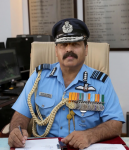Air Marshal RKS Bhadauria To Be The Next Chief Of The Indian Air Force
By Chandrashekhar Bhattacharyya - September 20, 2019

On Thursday, 19 September 2019, the Government of India announced that Air Marshal Rakesh Kumar Singh Bhadauria, PVSM, AVSM, VM will take over as the next Chief Of Air Staff (CAS), Indian Air Force (IAF) from Air Chief Marshal Birender Singh Dhanoa, who superannuates on 30 September 2019 after a tenure spanning two years and nine months. Given the above, it behooves us to take a quick look at AM Bhadauria’s distinguished record of service with the IAF.
An alumnus of the National Defence Academy, Pune, Bhadauria was commissioned into the IAF in June 1980, and has since clocked over 4250 Hours of flying on nearly 26 different types of aircraft. Back in the day, as a Wing Commander, he commanded a frontline Jaguar Deep Penetration Strike Squadron on the South Western Sector, facing Pakistan.
Affectionately called ‘Chhotu’ by his peers and seniors, it would be no understatement to say that he has an exceptional flying record. An ace flier, AM Bhadauria is also a ‘Category A’ ‘qualified flying instructor’. In the past he has also served as a master green experimental test pilot, and as a pilot attack instructor for the IAF’s prestigious Tactics and Air Combat Development Establishment, Gwalior.
Beyond his obvious pedigree as a flier, lies the fact that he has made critical contributions towards the evolution of the indigenous HAL Tejas Light Combat Aircraft (LCA) into an operational flying platform. Indeed, AM Bhadauria’s long association with the LCA programme, has seem him serve noteworthy tenures as the Commanding Officer of Flight Test Squadron at the Aircraft and System Testing Establishment (ASTE), Bengaluru and as the Chief Test Pilot and Project Director of the National Flight Test Centre, Bengaluru.
Flag Rank Experience
More recently, AM Bhadauria serving as Deputy Chief of Air Staff, at Air Headquarters, headed the Price Negotiation Committee set up for the purchase of 36 Dassault Rafale aircraft for the IAF. This was followed by his tenure as Air Officer Commanding in Chief (AOC-in-C) of Southern Air Command,Thiruvananthapuram from March 2017 to August 2018 during which he performed a notable solo flight in a Tejas MK-1. From August 2018 to May 2019 he served as AOC-in-C Training Command.
Vice Chief Of Air Staff, since May 2019, AM Bhadauria is set to take over as CAS on 30 September 2019.
Awards and Recognition :
AM Bhadauria was decorated with the Vayusena Medal in 2002, the Ati Vishist Seva Medal in 2013 and the Param Vishist Seva Medal in 2018. In 2019, he was made an Honorary Aide-de-Camp (ADC) to the President of India
© Delhi Defence Review. Reproducing this content in full without permission is prohibited.
Air Marshal RKS Bhadauria To Be The Next Chief Of The Indian Air Force
By Chandrashekhar Bhattacharyya - September 20, 2019

On Thursday, 19 September 2019, the Government of India announced that Air Marshal Rakesh Kumar Singh Bhadauria, PVSM, AVSM, VM will take over as the next Chief Of Air Staff (CAS), Indian Air Force (IAF) from Air Chief Marshal Birender Singh Dhanoa, who superannuates on 30 September 2019 after a tenure spanning two years and nine months. Given the above, it behooves us to take a quick look at AM Bhadauria’s distinguished record of service with the IAF.
An alumnus of the National Defence Academy, Pune, Bhadauria was commissioned into the IAF in June 1980, and has since clocked over 4250 Hours of flying on nearly 26 different types of aircraft. Back in the day, as a Wing Commander, he commanded a frontline Jaguar Deep Penetration Strike Squadron on the South Western Sector, facing Pakistan.
Affectionately called ‘Chhotu’ by his peers and seniors, it would be no understatement to say that he has an exceptional flying record. An ace flier, AM Bhadauria is also a ‘Category A’ ‘qualified flying instructor’. In the past he has also served as a master green experimental test pilot, and as a pilot attack instructor for the IAF’s prestigious Tactics and Air Combat Development Establishment, Gwalior.
Beyond his obvious pedigree as a flier, lies the fact that he has made critical contributions towards the evolution of the indigenous HAL Tejas Light Combat Aircraft (LCA) into an operational flying platform. Indeed, AM Bhadauria’s long association with the LCA programme, has seem him serve noteworthy tenures as the Commanding Officer of Flight Test Squadron at the Aircraft and System Testing Establishment (ASTE), Bengaluru and as the Chief Test Pilot and Project Director of the National Flight Test Centre, Bengaluru.
Flag Rank Experience
More recently, AM Bhadauria serving as Deputy Chief of Air Staff, at Air Headquarters, headed the Price Negotiation Committee set up for the purchase of 36 Dassault Rafale aircraft for the IAF. This was followed by his tenure as Air Officer Commanding in Chief (AOC-in-C) of Southern Air Command,Thiruvananthapuram from March 2017 to August 2018 during which he performed a notable solo flight in a Tejas MK-1. From August 2018 to May 2019 he served as AOC-in-C Training Command.
Vice Chief Of Air Staff, since May 2019, AM Bhadauria is set to take over as CAS on 30 September 2019.
Awards and Recognition :
AM Bhadauria was decorated with the Vayusena Medal in 2002, the Ati Vishist Seva Medal in 2013 and the Param Vishist Seva Medal in 2018. In 2019, he was made an Honorary Aide-de-Camp (ADC) to the President of India
© Delhi Defence Review. Reproducing this content in full without permission is prohibited.
Air Marshal RKS Bhadauria To Be The Next Chief Of The Indian Air Force






